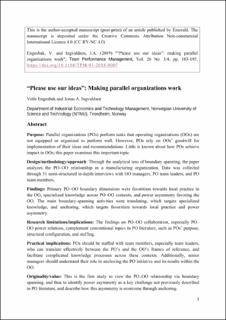| dc.contributor.author | Engesbak, Vetle | |
| dc.contributor.author | Ingvaldsen, Jonas A | |
| dc.date.accessioned | 2020-09-14T10:33:42Z | |
| dc.date.available | 2020-09-14T10:33:42Z | |
| dc.date.created | 2019-06-11T12:02:43Z | |
| dc.date.issued | 2019 | |
| dc.identifier.citation | Team Performance Management. 2019, 26 (3/4), 183-195. | en_US |
| dc.identifier.issn | 1352-7592 | |
| dc.identifier.uri | https://hdl.handle.net/11250/2677621 | |
| dc.description.abstract | Purpose
Parallel organizations (POs) perform tasks that operating organizations (OOs) are not equipped or organized to perform well. However, POs rely on OOs’ goodwill for implementation of their ideas and recommendations. Little is known about how POs achieve impact in OOs; this paper aims to examine this important topic.
Design/methodology/approach
Through the analytical lens of boundary spanning, the paper analyzes the PO–OO relationship in a manufacturing organization. Data were collected through 31 semi-structured in-depth interviews with OO managers, PO team leaders and PO team members.
Findings
Primary PO–OO boundary dimensions were favoritism toward local practice in the OO, specialized knowledge across PO–OO contexts and power asymmetry favoring the OO. The main boundary-spanning activities were translating, which targets specialized knowledge, and anchoring, which targets favoritism towards local practice and power asymmetry.
Research limitations/implications
The findings on PO–OO collaboration, especially PO–OO power relations, complement conventional topics in PO literature, such as POs’ purpose, structural configuration and staffing.
Practical implications
POs should be staffed with team members, especially team leaders, who can translate effectively between the PO’s and the OO’s frames of reference, and facilitate complicated knowledge processes across these contexts. Additionally, senior managers should understand their role in anchoring the PO initiative and its results within the OO.
Originality/value
This is the first study to view the PO–OO relationship via boundary spanning, and thus to identify power asymmetry as a key challenge not previously described in PO literature, and describe how this asymmetry is overcome through anchoring. | en_US |
| dc.language.iso | eng | en_US |
| dc.publisher | Emerald | en_US |
| dc.rights | Navngivelse-Ikkekommersiell 4.0 Internasjonal | * |
| dc.rights.uri | http://creativecommons.org/licenses/by-nc/4.0/deed.no | * |
| dc.title | “Please use our ideas”: making parallel organizations work | en_US |
| dc.type | Peer reviewed | en_US |
| dc.type | Journal article | en_US |
| dc.description.version | acceptedVersion | en_US |
| dc.source.pagenumber | 183-195 | en_US |
| dc.source.volume | 26 | en_US |
| dc.source.journal | Team Performance Management | en_US |
| dc.source.issue | 3/4 | en_US |
| dc.identifier.doi | 10.1108/TPM-01-2018-0007 | |
| dc.identifier.cristin | 1703950 | |
| dc.relation.project | Norges forskningsråd: 237900 | en_US |
| dc.description.localcode | This is the author-accepted manuscript (post-print) of an article published by Emerald. The manuscript is deposited under the Creative Commons Attribution Non-commercial International Licence 4.0 (CC BY-NC 4.0) | en_US |
| cristin.ispublished | true | |
| cristin.fulltext | postprint | |
| cristin.qualitycode | 1 | |

